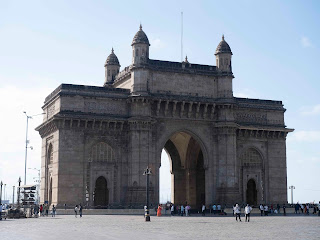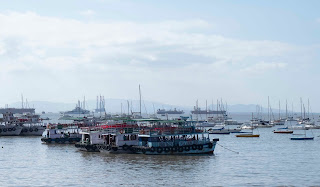Day 11: Mumbai
This morning we started with a walking tour of Mumbai.
The Gateway of India faces the Arabian Sea at Apollo Bunder in bustling Colaba area of Mumbai. It is the unofficial icon of the city of Mumbai and is a reminder of its colonial history. It is the first structure to welcome visitors entering the city by sea.
The Gateway of India was built to celebrate and honor the visit of King George V and Queen Mary to India for their formal proclamation as Emperor and Empress of India in December 1911. It was not completed, though until 1924.
 |
| India Gate |
The Taj Mahal Palace hotel located right next to the Gateway of India was built by Jamshedji Tata and catered to a clientele of British elites, European and Indian Maharajas.
Chhatrapati Shivaji Maharaj Vastu Sangrahalaya, formerly Prince of Wales Museum of Western India, museum in Mumbai (Bombay), India. It was established in 1905, but its opening was delayed until 1922.
 |
| Prince Albert Museum |
The next stop is the Keneseth Eliyahoo Synagogue in Colaba, built in 1884 by Jacob Sassoon of the Mumbai Sassoon family, who also built the Sassoon Docks.This is one of 10 existing synagogues that remain in Mumbai. (We visited another later today)
 |
| Sassoon Jewish Library |
 |
| Knesset Israel Synagogue |
Indian Jewry has three main communities—the Bene Israel, the Cochin Jews, and the Baghdadis. The Bene Israel Jews are by far the most numerous. Initially, they lived along the west coast of India. Over time, some of them migrated elsewhere. A handful of remaining Cochin Jews still live in Kochi (formerly Cochin). Baghdadi or Iraqi Jews are mainly found in Mumbai and Kolkata (formerly Calcutta).
The story of India’s Jewish community begins some 2000 years ago when, historians speculate, Jewish traders traveling from Judea came to India along the trade route and settled in Kochin. More came around 70CE when Jews were exiled from Israel following the destruction of the Second Temple.
Legend has it that these Jews, who came to be known as the Benei Israelis, were shipwrecked off the Konkan Coast (about 30 miles south of Mumbai) and lived isolated from other communities for hundreds of years until a Jew from Kochin came across them and recognized some of their customs.
Benei Israeli Jews, who have their own unique customs like the malida ceremony, were for a long time the majority of Jews in the country and were joined later by Baghdadi Jews fleeing persecution in the Middle East in the 18th and 19th centuries.
The vast majority of Indian’s Jews made aliyah after India won its independence from the British in 1947 and Israel became a state in 1948. Prior to partition, it is estimated that there were almost 30,000 Jews living in Mumbai alone. Today, the number of Jews living throughout all of India lingers somewhere between 3,000 and 5,000, with the vast majority of Bene Israel Jews living in Mumbai.
To help support the synagogue, we purchased some locally made matzoh and challah covers.
 |
| 3-Language Sidur |
We timed our walk to be at the main train station at 11:30 just in time to see the dabbawalas in action.The dabbawalas are a lunchboxdelivery and return system that delivers hot lunches from homes and restaurants to people at work in India, especially in Mumbai. When literally translated, the word "dabbawala" means "one who carries a box". The lunchboxes are picked up in the late morning, delivered predominantly using bicyclesand railway trains, and returned empty in the afternoon.
 |
| Dabbawallahs |
The service was born during the British Raj in the 1890s by Mahadeo Havaji Bachche out of sheer necessity. With more and more migrants of varying communities reaching the big city in those days and no fast food culture and office canteens around to feed workers, there was a lack of an effective system to ensure that office-workers could eat at lunchtime. There was also a supply of illiterate workers, who had travelled to the cities due to agriculture not being able to support them. With insufficient but with plenty of energy to undertake any hard work, the idea of delivering home-made food was born.
Lunch boxes are marked in several ways.
1. Abbreviations for collection points
2. Colour code for starting station
3. Number for destination station
4. Markings for handling dabbawala at destination, building and floor
A collecting dabbawala, usually on bicycle, collects dabbas either from a worker's home or from the dabba makers. As many of the carriers are of limited literacy (the average literacy of Dabbawallahs is that of 8th grade), the dabbas (boxes) have some sort of distinguishing mark on them, such as a colour or group of symbols.
The dabbawala then takes them to a sorting place, where he and other collecting dabbawalas sort the lunch boxes into groups. The grouped boxes are put in the coaches of trains, with markings to identify the destination of the box (usually there is a designated car for the boxes). The markings include the railway station to unload the boxes and the destination building delivery address.
At each station, boxes are handed over to a local dabbawala, who delivers them most often by bicycle. We watched as the dabbawalas loaded something north of 30 lunches onto each bike and then head off to distribute them around the city.
The empty boxes are collected after lunch or the next day and sent back to the respective houses. The dabbawalas also allow for delivery requests through SMS.
Each dabbawala, regardless of role, is paid around 8,000 rupees per month (about US$131 in 2014). Between 175,000 and 200,000 lunch boxes are moved each day by 4,500 to 5,000 dabbawalas.
 |
| Traditional lunchbox |
 |
| Monument to the Dabbawallahs |
 |
| Victoria Train Station |
 |
| City Hall |
A shortish bus ride (there really are no short bus rides in India) took us to Gandhi’s home and now museum.
 |
| Gandhi's Home |
Next we stopped to see a Jain Temple. Unfortunately, due to the potential for Covid 19, the temple was closed to anyone not a Jain.
 |
| Jain Temple |
 |
| Shoes back on |
Most of Mumbai’s laundry is done in enormous open-air laundries called dhodis. Laundry is collected from all over the city, hotels (I don’t think ours, more likely the 2 and 3 star hotels), restaurants (hopefully none that we frequented) and private homes and washed in simple machines or pounded on rock, then hung to dry in the sun. Very laborious process. The clean and dried laundry is then returned generally within a day (except in monsoon season)
 |
| Dhodis (commercial laundry) |
 |
| Delivering clean (?) laundry |
Our final stop for the day was the Magen David Synagogue located in the bustling neighborhood of Byculla, Mumbai, , an Orthodox Sephardi synagogue, was constructed in 1864 By david Sasoon for the growing population of Baghdadi Jews in Mumbai. Outside of Israel, this synagogue is the largest one for Baghdadi Jewish people in all of Asia. In 1910, due to the increase in the Jewish population in Mumbai, Jacob Sassoon, David’s grandson, extended the synagogue to host larger services for the congregation.
We were fortunate to meet the shamas of the synagogue (the lay sexton- pretty much what my dad did for the Beth Hillel for about 40 years). He was extremely animated and was thrilled to be able to tell us all about the community and the synagogue.
The synagogue has two Jewish schools associated with it. They were once exclusively for Jewish children, but due to the mass migration of Mumbai’s Jews, the number of Jewish children has been drastically reduced and the schools have opened to all children in the predominantly Muslim Byculla area. It’s at least nice to know that we can get along somewhere.
The caretaker at the sysnagogue notified the Rabbi (who was next door at the school) that a bunch of crazy Americans were ther visiting, and he came over (by bicycle) to kibbitz. The rabbi was Israeli, on loan to the Mumbsai Jewish community for 2 years. He spent about ½ hour entertaining us, telling us about the community, Judaism in India, and his life here with much needed humor. We all agreed he would be a great rabbi to have.
 |
| Mogen David Synagogue |
 |
| Hemesh on his way to converting |
 |
| Congregant at Mogen David, born and raised in India |
 |
| Rabbi from Israel |
On the way back to the hotel, we saw a half built Trump Towers that our president’s company, apparently backed out of.
This sign was the best part of the structure.
 |
| At the base of what was to be a Trump hotel. Project cancelled. |
Tomorrow we are off to the parks.






























































